Such is the magic of cruises, and there’s a reason people get so excited about escaping reality on the high seas. You hardly have to worry about the logistics of travel on a cruise, considered one of the least stressful methods of traveling. Considering how much of the trip will be handled for you before you leave land, such as ports of call, onboard activities, and even dining rotations, it’s easy to see why people like cruising so much.
But just because cruises seem like an easy way to bypass the hard work of vacations doesn’t mean they’re completely stress-free or safe. Faulty ship designs, accidental distractions, or having one too many drinks could be all it takes to turn your holiday on the water into a nightmare at sea. To learn more about cruise ship injuries, we surveyed over 1,100 people about their experiences on these vessels, the most common injuries they experienced or witnessed, and who they thought was at fault. Thinking about how you want to spend your vacation this year? Read on to see what we uncovered about the safety concerns of cruises.
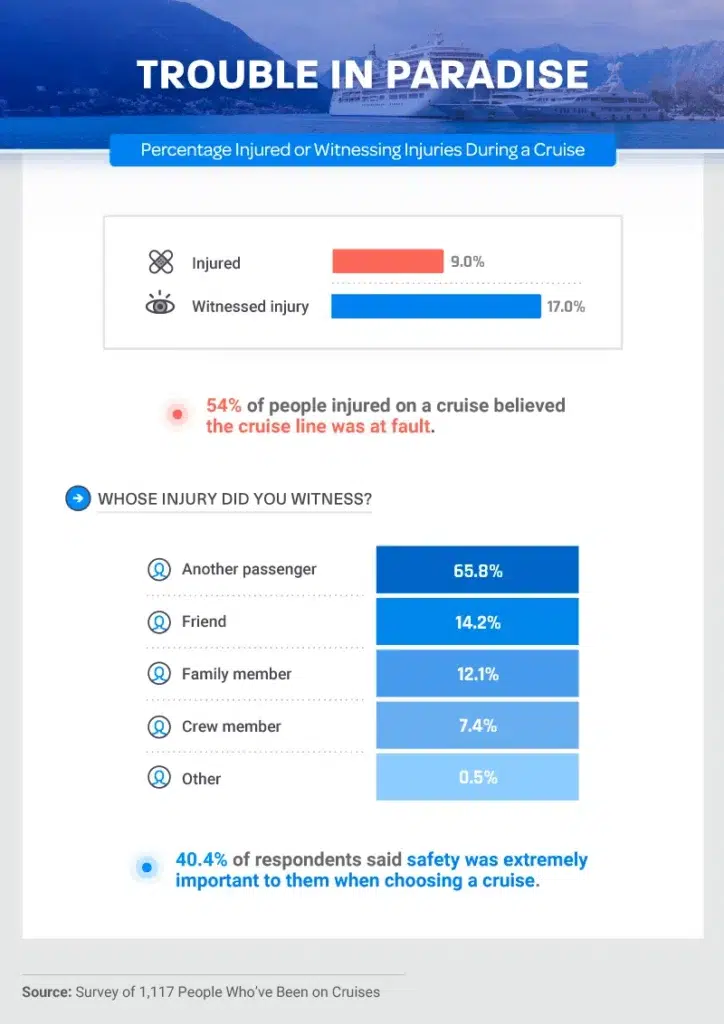
Safe in Open Waters?
In 2016, a cruise ship off the coast of Puerto Rico caught fire from the control room, causing 500 passengers to be evacuated. During the holiday season that same year, a passenger on a Royal Caribbean ship sailing from Port Everglades, Florida, fell overboard after consuming as many as 30 drinks and was never rescued. In 2018, 16 passengers were injured when a Norwegian Sky ship out of Seattle encountered a rudder problem that brought the ship to a grinding and immediate halt. Some passengers ended up with broken bones.
While these are not common experiences, they highlight the number of ways passengers may find their safety compromised on cruising vacations. According to people polled, nearly 1 in 10 travelers have been personally injured during a cruise. Another 17 percent witnessed injuries happening to others, including passengers they didn’t know (66 percent), friends (14 percent), and family members (12 percent). Overall, 54 percent of victims claimed their injuries were the cruise line’s fault.

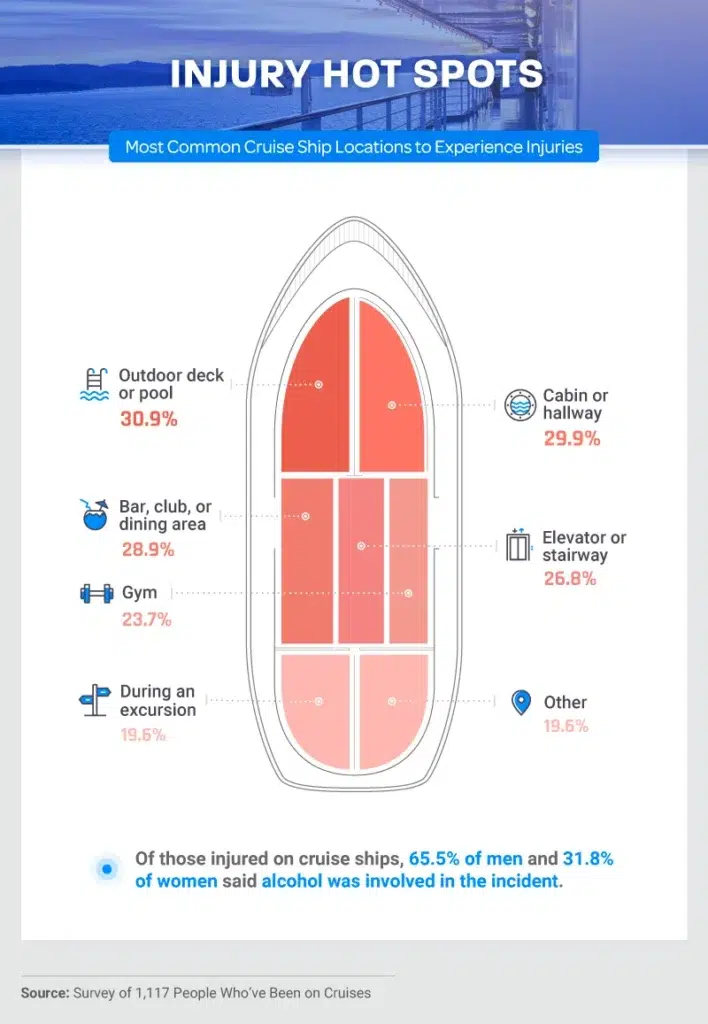
Strengthening Your Sea Legs
So where are most injuries happening on board ships? According to our survey, swimming pool areas or decks were the most dangerous places on cruises. Similar to pools on land, pools on ships can also quickly become dangerous or deadly. As we found, nearly 31 percent of those injured on ships said it happened on an outdoor deck or pool.
It wasn’t until 2017 that major cruise lines, including Norwegian and Royal Caribbean, added lifeguards to their onboard pools. Unfortunately, this wasn’t before an 8-year-old passenger drowned aboard the Royal Caribbean Anthem of the Seas in 2016.
Another 30 percent indicated injuries occurred in a cabin or hallway, and 29 percent got hurt in the bar, club, or dining area. Combined with the waves of the sea, alcohol also seemed to put some of our survey participants on shaky ground. Close to 66 percent of men and 32 percent of women injured on cruise ships admitted that alcohol was involved in their accidents. Although many cruise lines offer pre-purchase drinking packages, more might not always be better for those trying to stay safe on board.

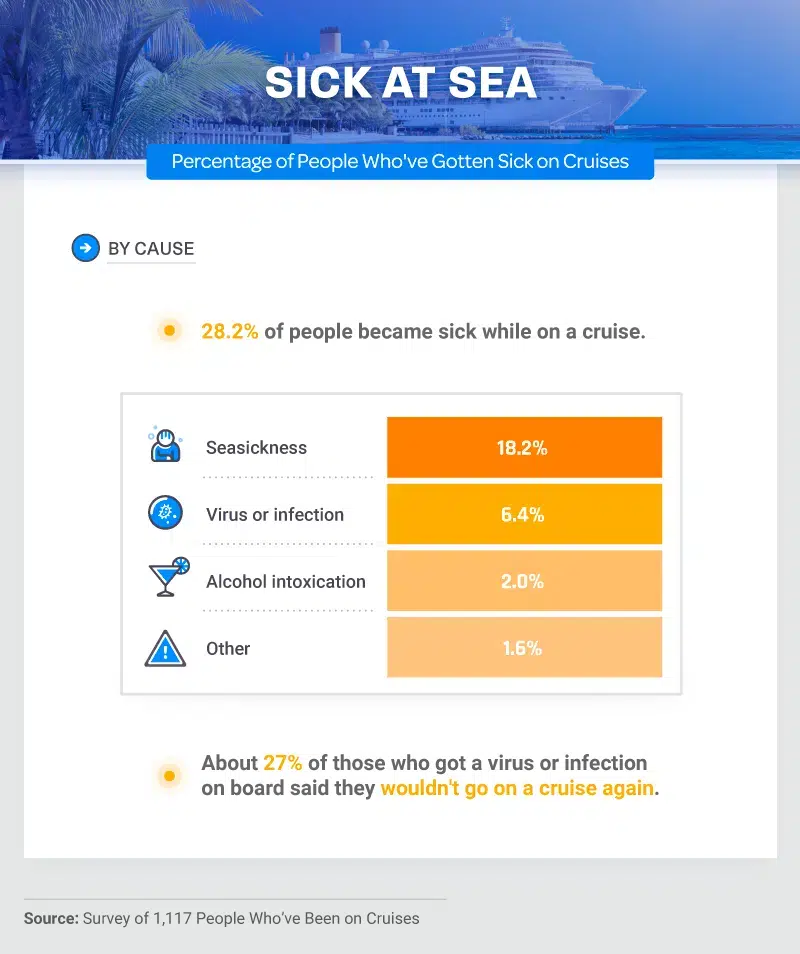
Feeling Under the Weather
Imagine planning out every detail of your vacation and saving up for the trip, only to discover once the ship pulls out of port, you start to feel a little queasy. What may start as a little bit of dizziness, caused by the sensory overload of motion on the boat, can quickly escalate into sweating, nausea, and even vomiting.
Roughly 18 percent of cruise passengers experienced seasickness, but another 6 percent encountered something more severe: viruses or infections. The close quarters on many cruise lines can become a breeding ground for illnesses like norovirus that spread through food, water, and contaminated surfaces. In December 2017, more than 200 passengers traveling on a Royal Caribbean ship became ill with a highly contagious gastrointestinal virus, and five people were hospitalized.
For some in our survey, sickness at sea ended the possibility of future cruises. More than 1 in 4 people who contracted a virus or infection on board a ship said they wouldn’t brave another cruise.
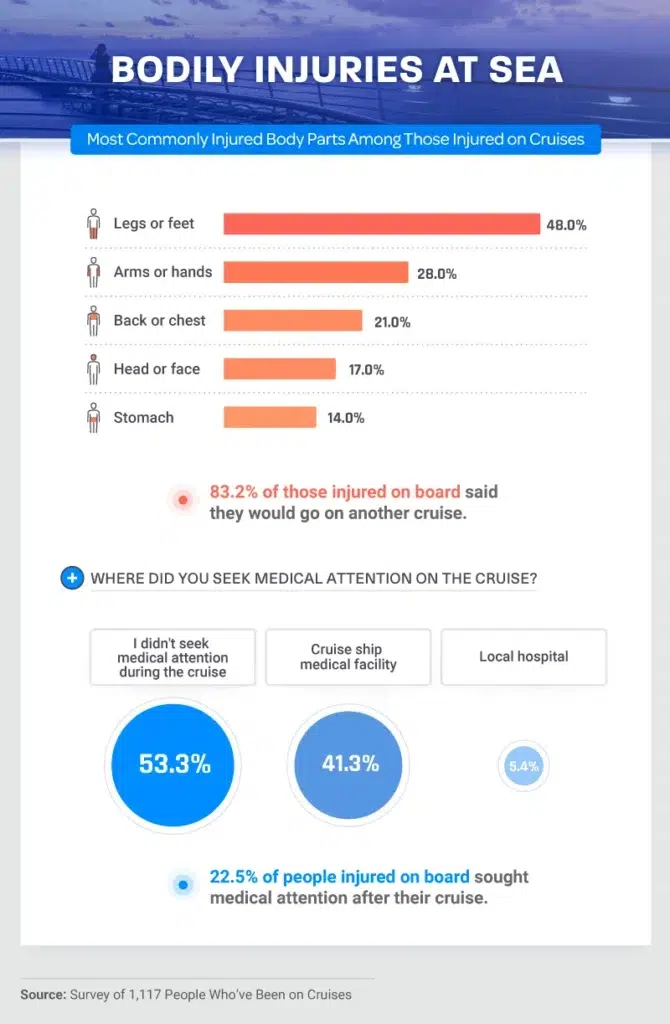
What to Expect After an Injury
No place seems more inconvenient to get injured or contract a virus than in the middle of the ocean. Thankfully, the Cruise Lines International Association (CLIA) set a standard for the medical resources ships are required to maintain. These are just a few of the care options you can expect while traveling by cruise (depending on the size of your boat and the number of passengers on board):
- Access to “reasonable” emergency medical care
- One or more doctors or nurses on board
- An on-site medical facility
- Bandages, medication, and sutures
- At least one intensive care unit (ICU)
- Oxygen
- Cardiac defibrillators
These available treatment options may help explain why around 83 percent of injured passengers were willing to cruise again. While roughly 53 percent didn’t seek medical care during their sailing, 41 percent used their ship’s medical facility throughout their travels.
For 48 percent of those injured, legs and feet were the most commonly affected body parts, although arms and hands (28 percent), the back or chest (21 percent), and the head or face (17 percent) were also frequently injured. Unfortunately, for some, arriving at home did not end their suffering. More than 1 in 5 people injured on cruises ended up seeking medical treatment after their trips ended.


Assault at Sea
Slipping and falling on the boat deck or picking up a virus aren’t the only things you might have to worry about on your next high seas adventure. Violent attacks, like muggings, drunken altercations, and even sexual assault, can happen even in the middle of the most beautiful and relaxing settings. In 2018, one altercation between passengers and crew members on a Carnival ship escalated into multiple fights over the 10-day excursion and resulted in at least 30 injuries. Following the incident, the ship scheduled an emergency stop, and 23 people from the same family were removed from the boat.
According to our survey, nearly 6 percent of men and about 3 percent of women were assaulted on their cruises. In these cases, almost 56 percent said the perpetrator was someone traveling with them. Another 31 percent said a member of the crew assaulted them, and close to 14 percent said the attack came from someone they didn’t know.
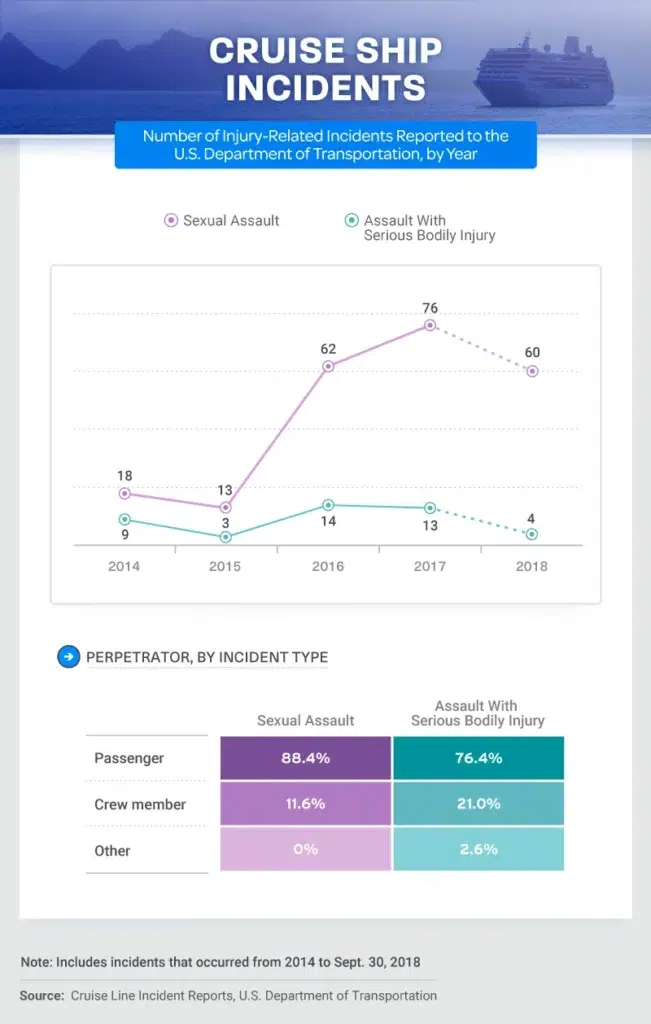
Incidents Over Time
In 2017, the number of sexual assault cases reported to the Bureau of Transportation Statistics (BTS) by major cruise lines increased sharply from the years prior. Analysts suggest the #MeToo movement has helped encourage victims of sexual assault on cruise ships to speak out about their attacks, but more may be going unreported. Although the number of reports is increasing, experts suggest the real figures could still be much higher.
According to BTS data, more than 3 in 4 sexual assaults that occurred on board cruise ships were committed by passengers, and about 11.6 percent were committed by crew members. A team of investigators from NBC also discovered that as many as 1 in 3 sexual assault victims on cruises were under the age of 18 at the time of the incident.
To protect victims at sea, who are too often swept under the rug by cruise lines, representatives have introduced legislation to Congress that would require cruise lines to report incidents to the FBI within four hours and install federal sea marshals on all ships. The legislation has not yet passed the Senate.
Preventing a Crisis
Cruises are supposed to be relaxing. After all, how could an all-inclusive trip to a warm, exotic part of the world be stressful? While you may go into your cruise expecting a worry-free experience, that may not always be what you get. Instead, nearly 1 in 10 people told us they’d personally been injured on a cruise, and another 17 percent saw someone else experience similar accidents. Even though there are expectations about the medical facilities on major cruise lines, they may not do you any good if you’ve picked up a nasty infection or seriously injured yourself on board.
Your safety isn’t guaranteed when you step onto your dreamboat. Instead, it’s important to be cognizant of the dangers that could be hiding in plain sight. Wear slip-resistant shoes, watch out for wet surfaces, drink in moderation, and don’t travel alone. However, if you’ve been hurt, physically or otherwise, during a cruise vacation, seeking expert legal advice may be your best plan of action.
At Farah & Farah, we are well-versed in maritime law and have extensive experience handling cruise ship injury cases. While we can’t treat your injuries or undo the suffering you’ve already endured, our experienced team will stand by your side until justice is done.
Methodology
For this study, we surveyed 1,117 Americans over the age of 18 who’d been on a cruise. 566 were men, 549 were women, and two considered themselves nonbinary. On average, the participants were 38.1 years old with a 13.3 standard deviation. 1,017 had not been injured on a cruise, and 100 participants had been injured on a cruise. 1,003 respondents were gathered using Amazon’s Mechanical Turk. The remaining 114 were recruited via cruise-related Facebook postings, forums, and Reddit.
What constituted an injury was left to survey participants’ discretion.
We supplemented our survey with sexual and bodily assault data from the Cruise Line Incident Reports from the U.S. Department of Transportation. We analyzed data from 2014 to September 30, 2018, the most recently published information.
Limitations
The sample sizes of some of the groups in this survey were as follows:
- Number injured in the gym: 23
- Number injured during excursions: 19
- Number injured in other places on the cruise ship: 19
- Number of people who witnessed a family member get injured: 23
- Number of people who witnessed a crew member get injured: 14
- Number who injured their back or chest: 21
- Number who injured their head or face: 17
- Number who injured their stomach: 14
Data collected using a survey that relies on participant reporting are characteristically flawed. Some of the factors that may have influenced the data are forgetfulness, hyperbolic statements, and dishonesty, among others.
Sources
- https://www.huffpost.com/entry/18-reasons-why-you-need-t_b_9518344
- https://www.latimes.com/nation/nationnow/la-na-puerto-rico-cruise-ship-20160817-snap-story.html
- https://www.sun-sentinel.com/2018/10/18/cruise-line-served-man-equivalent-of-30-drinks-before-he-went-overboard-suit-says/
- https://abcnews.go.com/US/story?id=93259&page=1
- https://www.thehealthy.com/first-aid/idden-pool-dangers/
- https://www.miamiherald.com/news/business/tourism-cruises/article145571359.html
- https://www.usatoday.com/story/travel/cruises/2018/10/18/cruise-ship-drink-beverage-packages-ultimate-guide/1650184002/
- https://www.medicalnewstoday.com/articles/176198
- https://www.cdc.gov/nceh/vsp/pub/norovirus/norovirus.htm
- https://qz.com/quartzy/1160465/norovirus-on-cruise-ships-how-it-happens-and-how-not-to-get-it
- https://www.acep.org/administration/resources/cruise-ships/prep—health-care-guidelines-for-cruise-ship-medical-facilities/#sm.00013748u762idvuq682gl0y4rg86
- https://time.com/5162751/carnival-cruise-ship-legend-fight/
- https://www.fastcompany.com/40533120/metoo-rocks-the-boat-cruise-lines-see-more-sexual-assault-reports-in-2017
- https://www.nbcnews.com/news/crime-courts/sex-assault-victims-cruise-ships-are-often-under-18-n777901
- https://www.congress.gov/bill/115th-congress/senate-bill/965
- https://www.insider.com/should-i-go-on-a-cruise-2018-4#its-the-epitome-of-a-worry-free-vacation-3
- https://traveltips.usatoday.com/safe-cruise-ship-1792.html
- https://www.transportation.gov/mission/safety/cruise-line-incident-reports
Fair Use Statement
Looking for your own all-inclusive access to our study? You don’t need a ticket to share these details. Feel free to use any of the results or graphics found here for any noncommercial use with a link back to this page included in your article.


















